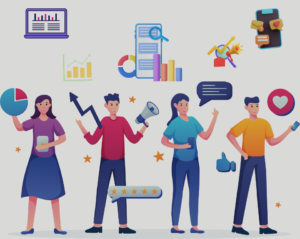According to a Statista survey of B2B marketers conducted in November 2022, 22% of people used LinkedIn to distribute their content, while 21% used Facebook. In B2B social media, LinkedIn is the most important social network for reaching out to business buyers and connecting with professionals in general. Building relationships, establishing thought leadership, generating leads, gaining insights, conducting market research, improving reputation, and creating online communities is all possible through the network.
Every B2B company wants to reach an audience on LinkedIn, Facebook, and Twitter, to get more leads. Social listening can turn data and information into a method to generate more content ideas that the audience wants to read and resonates with.
B2B social listening involves monitoring and analyzing conversations on social media to gather insights about a company’s target market, audiences, competitors, and industry trends. It can be used to inform marketing, product, and customer service decisions and to identify potential growth opportunities. This article provides a comprehensive guide to social listening for B2B organizations.
Why Social Listening Can Be a Valuable B2B Marketing Tactic
Content that truly resonates with the audience is what we should plan for. In B2B businesses, relevant content is of utmost importance. Marketing strategies for B2C are very different from those for B2B because they focus more on creating entertaining content and promoting products.
The power of Instagram can boost the sales of a B2C company with just one post. In comparison to B2C sales, B2B sales cycles are much longer. To solve B2B problems, prospective buyers seek expert companies that can provide products and services to increase their company’s revenue or save them money.
Considering what we discovered in our market research, what are the most challenging aspects of the prospect’s situation? How can we provide users with more information? We should answer these questions in the text. Consider using social listening to ensure the content matches the client’s needs. Business decisions are based on monitoring social media for customer feedback and mentions.
We can learn where questions are coming from by listening to what people say. We can help prospects and customers navigate as a business or spokesperson by stepping up and demonstrating our capabilities. The brand can be a voice and offer its perspective if, for instance, there needs to be clarity about the impact of a new regulation or standard in the industry.
Watch out: 6 Social Listening Trends In 2023 To Stay Ahead Of The Game
10 Ways to Use Social Listening Data to Improve Your B2B Marketing
It’s all about getting key messages across to the various stakeholders when it comes to public relations. A customer, investor, analyst, employee, potential employee, or community member could be one of these people. It’s imperative to listen when considering reaching and understanding these audiences.
A normal conversation wouldn’t consist of just talking, not listening, and talking back. It is the same in business communication. Using social media as a listening tool – in this case – can provide a wealth of data. It allows us to understand the key audiences, what our competitors are doing, and what potential customer service issues we may need to address. In social listening, we find and assess what is being said about a company, topic, brand, or person on social media. Rather than just monitoring, it goes a step further. It can make a huge difference to our business if we listen more.
To improve B2B marketing, here are 10 ways to use social listening data:
Social Listening Scenarios For New Product Development (NPD)
In B2B, NPD is complex and involves identifying customer needs, developing and designing new products or services, and bringing them to market. Monitor and analyze social media channels, forums, and other online platforms to understand what customers are saying. Insights into customer needs, preferences, and pain points can be used to inform new product development.
Scenarios of social listening situations for NPD are as follows:
- To find common customer pain concerns: businesses can utilize social listening to track online conversations about their sector, product line, or brand. The corporation can use this knowledge to create a new product that answers this client’s wants and pain points.
- Keeping an eye on competitor activity: A business can use social listening to monitor mentions of its rivals’ brands and products on social media and other internet platforms. This can assist the business in figuring out market gaps or places where their rivals are lacking, which can guide their NPD approach.
- Monitoring emerging trends: A business might utilize social listening to keep an eye on online discussions regarding new trends in their sector or range of products. This might assist the business in locating fresh chances for product creation or in changing its NPD approach to take advantage of new trends.
Lead Generation
Identifying and attracting the ideal customer is the first step in generating B2B leads. Identify the buyer persona, also known as the ideal customer. A B2B buyer persona is more than just a lead or contact. Ideally, this is the person who makes decisions on behalf of the ideal client. The person who will buy the product and shell out the money. This decision, therefore, requires considering what impacts them. There are many ways to use social media for lead generation in B2B marketing. However, how do we know that it works at all? It’s only possible through social listening!
The data collected needs to be measured and analyzed. This can be accomplished using software such as Hootsuite or Google Analytics. There are analytical programs on Facebook, Instagram, and LinkedIn. With all the data together, we can see which methods worked and which did not. What were the results of the paid advertisements? How much traffic does Facebook bring to our website? Does Twitter convert our followers into customers? Analyzing our data allows us to make improvements for our business that generate more leads.
Evaluate Customer Sentiment
Marketers must be aware of consumer perceptions of their brands because these perceptions should guide all parts of their content and marketing strategies. Finding online conversations about the brand is the first step in performing social media sentiment research. Tracking hashtags or keywords on social media sites such as Twitter and Instagram can help with this. Creating streams for the names of the products and services is crucial. The last stage entails assessing the sentiment contained in the mentions, which includes figuring out which terms might be used to discuss the brand positively or negatively. This procedure can be automated using programs like Hootsuite. Because sarcasm and other subtleties may alter the sentiment analysis, it is crucial to consider the post’s context while evaluating sentiments.
Competitor Analysis
A social media competitive analysis aims to benchmark the results against those of industry leaders to uncover growth opportunities and areas where the strategies may be underperforming. One will specifically benefit from a competitive analysis of social media:
- Find out who our social media rivals are.
- Identify their social media accounts and the platforms they use.
- Recognize the effectiveness of their social media approach.
- Compare our social media performance to that of the opposition.
- Determine the societal threats to our company.
- Look for weaknesses in our own social media marketing plan.
PR Impact Evaluation
To evaluate our PR plan’s success, we had to rely on focus groups and industry op-eds. However, social media provides a faster and more direct way to gain valuable insights into how our brand is perceived. By listening to voices on social media, we can quickly obtain knowledge and measure the effectiveness of our PR strategy, whether we are handling a crisis or promoting a new brand image. This approach is essential for both B2B and B2C purposes. Social media monitoring is an excellent way to gain insight into how the brand is performing and identify potential improvement areas.
Influencer Discovery
Potential influencers can be found through social listening, creating new marketing opportunities, and building brand relationships. This is because social media influence can change quickly, and relying on a few influential people may leave rivals behind. We may position the company to benefit from the emerging trend of digital influencer marketing in the B2B sector by actively listening to the conversations taking place on social media from the outset of their rise. Additionally, social listening can assist in identifying people who engage with the material or are talking about pertinent subjects. These people can be invaluable connections for developing collaborations and extending their reach.
Employee Satisfaction
The mood and morale of our staff can be seen clearly through social listening, which may affect how potential customers view our company. Many employees are finding it difficult to work remotely because of COVID-19 restrictions, and social listening can assist in spotting possible issues before they get out of hand and reach HR. Maintaining a positive employer brand online is essential for effective recruiting and employee retention. While workers might not express their unhappiness on popular social media platforms, keeping an eye on less popular ones can give early signals. Potential business transactions with our organization may be put off by a poor employer brand.
Brand Reputation
We may improve our brand’s reputation, increase word-of-mouth marketing, find new unique selling propositions (USPs), and quickly monitor the actions of our rivals by putting a social listening strategy into place. Understanding how our consumers, prospects, and business partners feel about our brand in real-time is invaluable, and social listening gives us this ability.
Additionally, social listening not only reveals places for development but also what the clients’ and prospects’ needs are. In business and marketing, it’s crucial to comprehend customers’ problems and how our brand can solve them. We may give better customer service and develop a following of devoted customers by anticipating their requirements. We may give better customer service and develop a following of devoted customers by anticipating their requirements.
Sentiment Analysis
Social media sentiment analysis enables businesses to follow online discussions about themselves and their rivals in real-time and obtain quantifiable perception insights. Sentiment analysis helps identify how brand decisions affect consumer image and loyalty by examining the feelings and opinions shared on social media. The goal of this procedure, also referred to as “opinion mining,” is to better understand brand sentiment by collecting and analyzing social data. Any social media tracking strategy must include social sentiment measurement, which can be done with the help of several marketing-related tools.
Real-time Business Insights
Real-time social listening keeps product development and marketing initiatives on track and enables us to react to circumstances that could endanger our reputation. The brand’s reputation is seriously threatened by unsuccessful marketing campaigns and data breaches. Prompt and suitable answers are necessary to safeguard the company’s reputation and increase confidence among consumers and clients, as well as within the business. Brands need to be more conscious of each tweet and post’s general and political tone as consumers voice their unhappiness on social media and viral trends spread in seconds. To avoid possible PR disasters, teams must be prepared to handle damage control right away.
Conclusion
In conclusion, social listening is an effective technique for B2B marketers to learn more about their target market, audiences, rivals, and market trends. It can help decision-makers in the marketing, product, and customer service industries spot expansion prospects. The article emphasizes the value of LinkedIn for business-to-business social media and offers 10 ways to leverage social listening data to enhance B2B marketing, including examples for lead generation, new product creation, competitor analysis, and brand reputation management. B2B organizations may develop content that resonates with their audience, assists them in navigating challenging situations, and answers their wants and challenges by listening to what people have to say.












